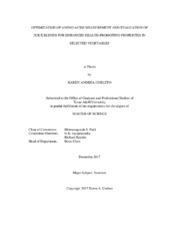| dc.description.abstract | Amino acids are involved in numerous biological processes such as protein synthesis, cell signaling, and immune response, and some act as antioxidants. In the first study, a rapid, sensitive and reproducible HPLC-FLD method was developed for the quantification of amino acids including L-citrulline from vegetables juices and commercial juices. The method separated 21 amino acids using an octylsilyl stationary phase. Optimal separation conditions were obtained with 20 mM sodium acetate buffer (solvent A) and water with organic modifier acetonitrile and methanol (solvent B). The developed method was validated with six vegetable juices: watermelon, cucumber, celery, calabaza squash, zucchini squash, yellow squash and commercial juice samples. Results demonstrated that L-citrulline content was highest in watermelon juice.
Nitrate and polyphenols from the diet may enhance the production and bioavailability of nitric oxide, a radical signaling molecule essential for cardiovascular health. In the second study, the stability of nitrate and total phenolics in beetroot and arugula juices was measured over one month at different temperatures. The levels of nitrate were highest at the initial day samples for beetroot and arugula juices. At 25 °C nitrate degradation initiated within 24 h, whereas nitrate remained stable in frozen samples for one month. UPHLC-HR-QTOF-MS was applied for the identification of bioactive compounds such as betacyanins, polyphenols and their degradation products from beetroot and arugula juices.
In the third study, the juices of watermelon, beetroot, kale, arugula, and six different juice blends were evaluated for their bioactive composition, amino acid profile and antioxidant activity. Results demonstrated that beetroot juice had the highest level of nitrate followed by kale and arugula. For the blends, B-1 and B-2 had significantly higher levels of nitrate than the other juice blends. Watermelon juice was found to have the highest levels of L-citrulline followed by blend B-6. The juices were also freezedried and then evaluated for their nitrate and L-citrulline content. In conclusion the blending of vegetable juices can increase the levels of bioactive compounds and enhance the nitrate and L-citrulline content, which may lead to improved cardiovascular health and sports performance. | en |


